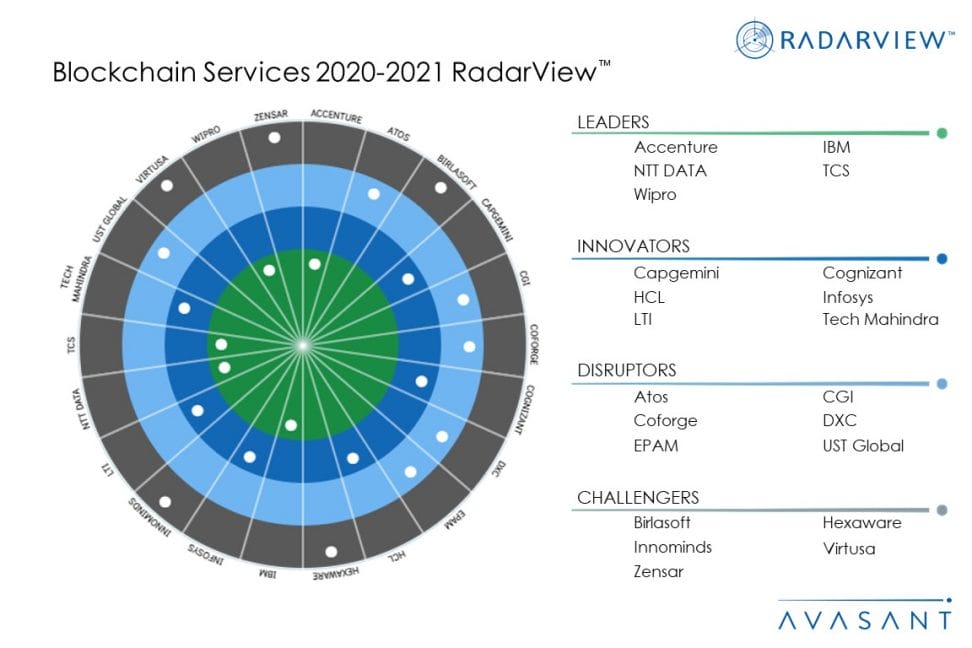Over the past 12 months, blockchain has moved beyond the hype as companies have realized business value from select use cases. Even though overall blockchain adoption has slowed down, the number of production-grade implementations has doubled, showing that blockchain is gaining a new level of maturity.
These emerging trends are covered in Avasant’s Blockchain Services 2020-2021 RadarView™ report. The report is a comprehensive study of blockchain services, including top trends, analysis, recommendations, and a close look at the leaders, innovators, disruptors, and challengers in this market.
Avasant evaluated 30 providers using three dimensions: practice maturity, investments and innovation, and industry development. Of those 30 providers, we recognize 22 as having brought the most value to the market during the past 12 months.
The report recognizes service providers in four categories:
-
- Leaders: Accenture, IBM, NTT DATA, TCS, Wipro
- Innovators: Capgemini, Cognizant, HCL, Infosys, LTI, Tech Mahindra
- Disruptors: Atos, CGI, Coforge, DXC, EPAM, UST Global
- Challengers: Birlasoft, Hexaware, Innominds, Virtusa, Zensar
Figure 1 from the full report illustrates these categories:

“Enterprise approach to Blockchain has resoundingly shifted from doing pilot projects to explore the technology, to investing in use cases where real business value has been generated,” said Swapnil Bhatnagar, research director with Avasant. “While it may seem that the overall growth slowed down in the last twelve months, the fact is that more companies are now seeing blockchain as a real and pragmatic solution to specific business problems. We expect that this will lead to sustained growth and investment in this space by enterprises.”
Key findings from the report include:
- Temper your expectations from blockchain, but don’t give up on it:
-
- Do not look at blockchain as a silver bullet. It can help solve some specific business problems, but it is not the universal answer to all business needs.
- Invest in blockchain for those use cases that have demonstrated business value. These use cases include: identity management, supply chain management, cross-border payment, invoice reconciliation, and document digitization.
- Move beyond cost-centric business cases:
-
- Even though blockchain’s initial impact is aimed at reducing costs, true disruption lies in other business drivers such as transforming business models, mitigating risks, and creating social impact.
- Generate new revenue streams by combining analytics with data captured by blockchain. Blockchain’s ability to reduce counterfeiting and fraud, and support initiatives such as voting and election management, places it in a strong position to mitigate risks and create social impact.
- Set a pre-consortium agreement for a road test of a formal consortium:
-
- Benefit from early alignment and buy-in from members by ensuring a road test through a pre-consortium agreement that is more flexible and is intended to govern over a short-term.
- Before joining a formal consortium, document details including allocating responsibilities, risks, and liabilities. Address contributions, operations, governance, modification processes, and rules for exit and entry through a pre-consortium agreement.
- Adopt a private model to protect data and overcome business barriers:
-
- Private blockchains such as Hyperledger Fabric, Private Ethereum, Corda, and Quorum are specifically suited for enterprise blockchain adoption because of features including full privacy, high-efficiency, scalability, and robust architecture.
- The blockchain model gives enterprises more control, setting out clear expectations and obligations and, funding, operating , and governance models.
Avasant’s Senior Analyst Amrita Keswani, added, “Many companies are investing more in developing production-grade blockchain solutions. Progressive enterprises need to forge alliances with experienced service providers that understand the challenges on their blockchain journeys and harness blockchain with real-world applications.”
The full report also features detailed RadarView profiles of the 22 service providers, along with their solutions, offerings, and experience in deploying blockchain solutions.
This Research Byte is a brief overview of the Blockchain Services 2020-2021 RadarView™ report (click for pricing).

